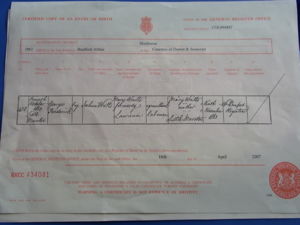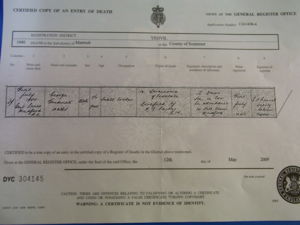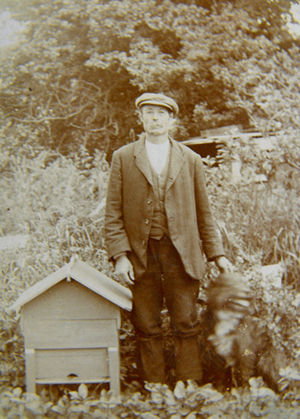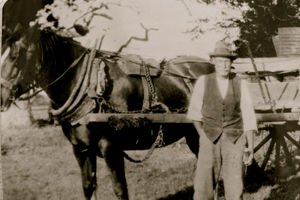Biography
Thanks to Roslyn Falvey for BDM certificates and photos of George used for this section.
The master version of this biography is maintained at http://dorneyfamilyhistory.net/famtree_web/History_tricia.pdf
George was born on 4 October 1863 in Little Marston, Somerset, the eldest of six children of Joshua Watts and Mary Lawrence. Little Marston was a farm not even one mile to the west of the village of Marston Magna.
In the 1871 Census we find George living in Chilton Cantelo with his parents and three younger siblings, his family having moved there a year or two previously. He was attending school. Chilton Cantelo and Little Marston are only two miles apart. He mustn’t have attended school for much longer, because at the age of seven he started working on a neighbouring farm. He rose shortly after five o’clock and would be employed until six-thirty in the evening. At the age of eight he was taking his turn with the men at ploughing.
By the time of the 1881 Census he had moved out of home, and was living as as servant dairy boy in the household of a James Easton in Symondsbury, Dorset. Symondsbury is close to the coast and about 25 miles south of Chilton Cantelo.
In 1885 George was living in Mudford where he joined the Methodist church, and he became a lay preacher and Sunday School teacher. A 1938 newspaper article stated that “His straightforward interpretation of the gospel is expressed in the purest Somerset dialect, and he is a welcome visitor at the little country chapels in the Circuit.” His future wife Bessie Higgins was living in Long Sutton while he was courting her. He used to walk from Chilton Cantelo to Long Sutton every week-end, which was ten miles each way. Later she moved to Closworth, but this was still ten miles away, just in another direction.
George was married to Bessie Higgins on 21 December 1888 in Chilton Cantelo, by the Rev. Goodford. The witnesses were Mary Higgins (Bessie’s sister) and J E Watts (possibly George’s brother Edward Joseph).
George was earning eleven shillings a week at the time of his marriage. Some prices at this time include 2s for a pound of tea, 2s 6d for a 30 word advert in the newspaper and 12s 11p for a black and brass double bedstead. It’s a good thing they would have had some land with their cottage to grow vegetables and perhaps keep a cow, chickens and even a beehive.
George and Bessie had four children together, Mary Eliza (1889), Rosie Annie (1891), Frederick James (1892) and William George (1899). They were living in Lower Chilton over this period, being captured in the 1891 and 1901 Censuses. George’s profession was given as agricultural labourer.
The building pictured (actually three ‘cottages’) is one of four built in 1867 in Lower Chilton for the Goodford Estate. The cottages are two or three bedrooms and range in size from 87 to 95 m2, although the central one may be smaller.
George and his family lived in one of these cottages, which seem much more comfortable than I imagined for farm workers in the late nineteenth century.
A recent real estate advert boldly claimed that author Thomas Hardy may have designed them, but while possible, Hardy was better known for his church renovations – he worked on the St James church renovation here in 1864-5.
The house is also described as having “..brick walls with string courses, hamstone mullions, kneelers and quoins all under a clay tiled roof.”
Their home would have been a ‘tied cottage’ arrangement. This means the right to live in the property was dependent on having employment with the owner.
The four buildings can be seen to the left of the world Lower on the map. The school the children would have attended is towards the top.
On the night of the 1911 Census George was home alone at Hinton Farm, Mudford, and working as a shepherd (the map in Bessie’s chapter shows Hinton Farm). He was alone because Bessie and their youngest son William were visiting the Coles family at Broughton Gifford, Wiltshire, a village just to the west of Melksham, and 45 miles from home. Mary Coles was Bessie’s sister.
In 1912 George started serving on the board of the Parish Council, where he continued until 1937.
While working at Hinton farm he twice advertised goods in the newspaper. In 1914 he was selling six swarms of bees, and in 1919, fifteen tons of mangolds.
Mangold are a tuberous plant used as stock feed. Given the large scale of the items advertised for sale, these were probably on behalf of his employer.
They moved to East Lane, Mudford in about 1920, where he had bought a smallholding. East Lane is not actually a name for a road, but an area on the main road, a little south of the village proper and where the current cemetery is located.
A smallholding is land used for agricultural purposes, but is much smaller than a farm. The production was not just for personal consumption, but also sold. In 1938 he was advertising mangold for sale.
In 1925 George (presumably with Bessie) went to the pictures to see his first and only film. The film was the original silent production of Ben Hur, subtitled A Tale of the Christ. George went to see it because he had read and been thrilled by the book.
George and Bessie celebrated their Golden wedding anniversary in 1938, which was also Bessie’s 70th birthday. He was 76 years old, and still did his usual milking and farm chores in the morning.
Interviewed on the day, he declared “I have had a wonderful time” and went on to say that he could not recall having an illness, and a doctor had attended him only once after a fall from a hayrick. He also stated that “I have been for three days’ holiday in my lifetime”. The family celebration was held at the village hall, with thirty friends and relatives attending.
A further fifty messages of greeting and a similar number of presents were received. The letters included a letter from their son Fred from Australia, and a cablegram from Bessie’s brother Arthur in Toronto.
George died on 1 July 1940 of prostate cancer. He was 76 years old. He doesn’t seem to have had a death notice in the newspaper, and if he was buried at Mudford, a headstone. The National Probate calendar listed the value of his effects as £442 10s, which would have been largely the value of his house and land.
Sources
- Registry Office Certificates (all attached)
It may be possible to confirm family relationships with George by comparing test results with other carriers of his Y-chromosome or his mother's mitochondrial DNA. However, there are no known yDNA or mtDNA test-takers in his direct paternal or maternal line. It is likely that these autosomal DNA test-takers will share some percentage of DNA with George:
-
~6.25%
Alison Head
 :
AncestryDNA, GEDmatch A755232 [compare], Ancestry member Alison_Head
:
AncestryDNA, GEDmatch A755232 [compare], Ancestry member Alison_Head
Have you taken a DNA test? If so, login to add it. If not, see our friends at Ancestry DNA.
Rejected matches › Josiah George Watts (1862-1940) › George Watts › George Marshall Watts (1815-1904) › George B Watts › George Watts › George J Watts › George Watts › George Archibald Watts (1900-abt.1973) › George W. Woods (abt.1865-)
Featured Female Poet connections: George is 20 degrees from Anne Bradstreet, 14 degrees from Ruth Niland, 32 degrees from Karin Boye, 32 degrees from 照 松平, 19 degrees from Anne Barnard, 39 degrees from Lola Rodríguez de Tió, 22 degrees from Christina Rossetti, 21 degrees from Emily Dickinson, 33 degrees from Nikki Giovanni, 23 degrees from Isabella Crawford, 16 degrees from Mary Gilmore and 20 degrees from Elizabeth MacDonald on our single family tree. Login to find your connection.





